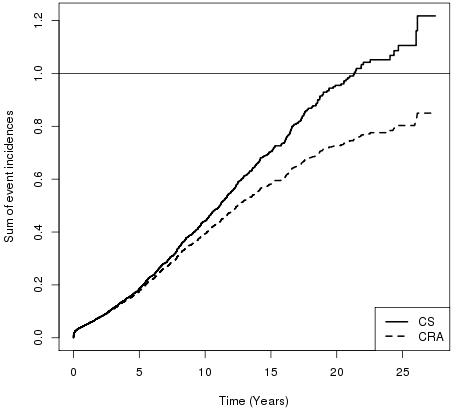Competing Risk Analysis in Renal Allograft Survival: A New Perspective to an Old Problem
1Medicine, Mayo Clinic, Rochester, MN
2Biostatistics, Mayo Clinic, Rochester, MN.
Meeting: 2018 American Transplant Congress
Abstract number: D96
Keywords: Kidney transplantation, Survival
Session Information
Session Name: Poster Session D: Kidney Complications: Late Graft Failure
Session Type: Poster Session
Date: Tuesday, June 5, 2018
Session Time: 6:00pm-7:00pm
 Presentation Time: 6:00pm-7:00pm
Presentation Time: 6:00pm-7:00pm
Location: Hall 4EF
Background:Patient and graft survival after kidney transplant (KTX) is often estimated by Kaplan-Meier censoring for competing factors, e.g.death-censored graft survival. However when the competing factor (death) occurs at different rates in some subgroups (e.g. diabetic (DM)or elderly) this can lead to over/underestimation of survival probabilities. To assess the accuracy of survival probabilities we compared kidney/patient survival using censored survival (CS) ie KM/Cox regression and competing risk analysis (CRA).
Methods:Included 3184 adult KTX from 1990 to 2014. Median follow-up 61.9 m, 61.2% males,24.6% diabetics and 74.2% living donor KTX. End points were graft loss before death and death before graft loss. We then compared combined probability of events, death+graft loss using both CS and CRA.
Results:Probability of death and graft loss (both censored for the opposite outcome)was significantly higher by CS than CRA and differences increased with follow-up time. During the first 7 years post-KTX, CS and CRA estimates were similar. By 20 years,the probability of graft loss was 46.3% by CS and 34.1% by CRA (probability of death 49.2% and 38.7%, respectively). CS overestimated risk such that the combined probability of death+failure exceeds 100%. Importantly, differences in graft losses were magnified in subgroups with different probabilities of death. Among DM at 20 years, probabilities of graft loss were 56.7% by CS and 32.1% by CRA while in non-DM were 44.1% and 34.6%. The probability of graft loss by CS or CRA among 18-30 yo was similar (40.1vs 38.8%), however, among older recipients (>60yo) CS overestimated significantly the probability of graft loss compared to CRA (41.3 vs 21.8%). Conversely,probability of death was significantly overestimated by CS in 18-30 yo but was comparable in >60 yo recipients (83.4 vs 68.4%). 
Conclusions:When estimating probability of long term graft survival and death, CRA gives more accurate measure especially in subgroups with different rate of competing event. Overestimation of risk by CS leads to misinterpretation of major outcomes of KTX that are likely better than currently reported.
CITATION INFORMATION: El ters M., Smith B., Cosio F., Kremers W. Competing Risk Analysis in Renal Allograft Survival: A New Perspective to an Old Problem Am J Transplant. 2017;17 (suppl 3).
To cite this abstract in AMA style:
ters MEl, Smith B, Cosio F, Kremers W. Competing Risk Analysis in Renal Allograft Survival: A New Perspective to an Old Problem [abstract]. https://atcmeetingabstracts.com/abstract/competing-risk-analysis-in-renal-allograft-survival-a-new-perspective-to-an-old-problem/. Accessed December 28, 2025.« Back to 2018 American Transplant Congress
